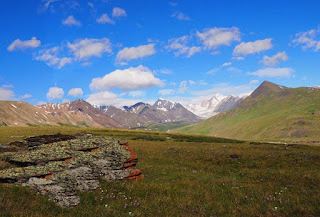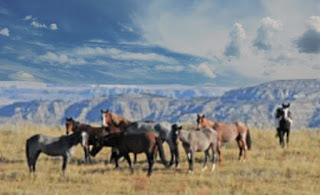According to Daniel Johnson 9left), in a presentation given at the Book of Mormon Archaeological Forum’s 2012 conference, there is hard evidence to show that horses survived in the Americas. As he states: “Although incomplete, the geological and archaeological record does provide support for horses and even wheeled vehicles in ancient America. The extinction of the ancient horse and the origins of the modern horse in the Americas have become clouded and unsure in light of the latest research. Much of this evidence is not questionable or even that new, but still, sadly, both critics and faithful members are unaware of it. Several valid arguments are worth considering” ("Hard" Evidence of Ancient American Horses,” BYU Studies Quarterly, Journal 54:3, pp149-177).
Although hard evidence is available to consider, so far no incontrovertible proof of Book of Mor- mon horses exists—that is to say, physical remains conclusively dated to around 500 bc (and earlier) from supposed Book of Mormon lands in Mesoamerica are yet to be found. Because of this, more than any other criticism of the Book of Mormon, its inclusion of horses has generated greater accusation of its supposedly fraudulent nature. The horse is still used in this day and age to cast doubt on the book’s divine origins.
In the Book of Mormon references to horses are few and not a central part of the narrative. Early on, the Jaredites had horses—interestingly, the elephants, cureloms, and cumoms mentioned in the Jaredite history, which are nowhere to be found in the Nephite records, however, the horse is, though seemingly in a lesser role. With the Jaredites, the horse was delegated to a secondary role behind elephants, cureloms and cumoms (Ether 9:19), and with Nephi, was mentioned equally with other domestic animals (1 Nephi 18:25). A generation later, horses were still available among the Nephites, again seemingly on an equal footing with domestic animals (Enos 1:21). As mentioned earlier, the Lamanite king Lamoni is described as having horses and chariots (Alma 18:9–10), and the Nephites had numerous horses and chariots, with seemingly greater importance than other domestic animals (3 Nephi 3:22) and when they returned to their lands after dealing with the Gadianton robbers (3 Nephi 6:1).
For generations, science has claimed the horse became extinct in the Americas around 8,000 years ago, though no specific reason or evidence can be produced to support that claim. The one factor most often claimed is that the Spanish conquerors did not find any horses when they invaded Mexico, Central America, and Andean South America. However, the land factor covered by these invasions inolved only a tiny amount of the vast prairies, woodlands, mountains and altiplanos. There are many who think that there were horses in the Americas, but not where the Spanish conquistadors and later Europeans traveled.
The
non-feral wild horse Przewalskii, or Mongolian wild horse
As an example, the rugged and remote far reaches of western Mongolia are a series of wild landscapes capped by glacier-wrapped mountains, divided by green river valleys and shadowed by soaring peaks. This area is home to the famous Kazakh eagle hunters and has some of the best preserved petroglyphs in the country. But it is the majestic Altai Mountains that dominate this isolated corner of Mongolia. Straddling the borders with Russia and China, the Tavan Bogd is a cluster of Mongolia’s soaring peaks and a draw for climbers, trekkers and horse riders. It culminates in the dramatic 14,350-feet high Khüiten Peak, the highest point in the country.
The tarpan or European wild horse (Equus ferus ferus) was found in Europe and much of Asia. It survived the extinction event and lived into the historical era, but became extinct in 1909, when the last captive died in a Russian zoo.
Isolated
Western Mongolia where the Equus przewalskiii was discovered
A truly wild horse is a species or subspecies with no ancestors that were ever domesticated. One of these, the Przewalskii horse resembles another truly wild horse, the now extinct Tarpan, or European wild horse (Equus ferus), whose ancestors were captured so vividly in the cave paintings in France and Spain in early BC times. The Przewalskii horse was once believed to be a direct ancestor of all living breeds. DNA testing, however, has revealed chromosomal differences between Przewalskiis and modern horses (Equus caballus) indicating that the title of prime progenitor more likely belongs to the European based Tarpan.
It should also be noted that wild horses (mustangs) have no natural predators. Without human intervention, herds will double in size every four years. This should suggest their sturdy capability of survival.
With the demise of the Nephites in 385 AD, it is likely the surviving horses they had were ignored by the warring Lamanites who were involved in protecting their numerous tribal separations. Many claim the horses were pushed to the extreme north and south, and their existence was forgotten by subsequent cultures inhabiting the original areas, who, by the time of the Spanish arrival, did not understand this “new” animal reintroduced during the Conquest.
The Chilean
Matorral is one of many places in the Andean area where small pockets of horses
could have been hidden for centuries
The Chilean Matorral is an ecoregion of central Chile, located on the west coast of South America. It is in the Mediterranean forests, woodlands, and scrub biome, part of the Neotropic ecozone.
A Matorral is typically characterized by a temperate Mediterranean climate, with rainy winters and dry summers. It is one of the world's five Mediterranean climate regions, which are all located in the middle latitudes on the west coast of continents. The Matorral occupies central Chile between 32° and 37° south latitude, with the Pacific Ocean to the west, and the Chilean Coastal Range lies parallel to the coast. The Chilean Central Valley lies between the Coastal range and the Andes Mountains, which bound the Matorral ecoregion on the east. To the north is the extremely dry Atacama desert, which separates the Matorral from the tropical forests of northern South America. A semi-desert region known as El Norte Chico (the "little north") lies between 28° and 32° south latitude, and is the transition zone between the Atacama desert and the Matorral. To the south lies the cooler and wetter Valdivian temperate rain forests, which includes most of South America's temperate rain forests.
The interesting fact is that throughout the rough and remote terrain of Andean South America there were (and even still are in some cases) areas where though once populated in BC times, the ancient populations died out and were not replaced, where horses and other animals could have been during the invasion and no one would have known they were there. Certainly there is much evidence to suggest such a possibility.
The Chilean
Matorral is but one of many remote areas, inhabited anciently, but not in the
last thousand years or more before the arrival of the Spanish, where horses
could have been without anyone knowing for centuries after the invasion
This is a solid hypothesis based on sound, up-to-date scientific research, such as artifact depicting a rider mounted on some indeterminate animal. Originally from Oaxaca, it now resides in the American Museum of Natural History in New York City. Described as a rattle, the wheeled effigy was obtained by Marshall H. Saville on one of his expeditions to Oaxaca between the years 1898 and 1902. The extraordinary feature is the human figure, unfortunately incomplete, seated on the animal’s back with legs clasping the sides of the animal in a manner exactly like that of a horseback rider. Clay fillets are also found behind and in front of the rider, obviously representing some form of saddle (Andrew K. Balkansky, “Saville, Boas, and Anthropological Archaeology in Mexico,” Mexicon Journal, Vol.27, No.5, October 2005, pp86-91).
Unfortunately, on this basis alone, this find has been classified as post-Conquest because common knowledge would deny the understanding of such a concept (or the animal necessary for it) before accepted European contact. However, some experts claim that no such artifacts were made after the arrival of the Spanish (Richard A. Diehl and Margaret D. Mandeville, “Tula and Wheeled Animal Effigies in Mesoamerica,” Antiquity, vol.61, no. 232, July 1987, p243).
The museum’s own listing for the artifact describes it as coming from the Late Classic/Postclassic Periods, AD 900–1521.


































